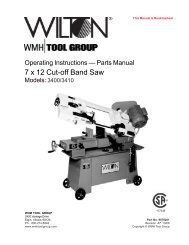D CDA3000 Inverter Drive System 750 W - 132 kW - Igor Chudov
D CDA3000 Inverter Drive System 750 W - 132 kW - Igor Chudov
D CDA3000 Inverter Drive System 750 W - 132 kW - Igor Chudov
Create successful ePaper yourself
Turn your PDF publications into a flip-book with our unique Google optimized e-Paper software.
A.5 Project planning<br />
notes for multimotor<br />
operation<br />
<strong>CDA3000</strong> Operation Manual<br />
Subject Project planning notes<br />
Current<br />
configuration of<br />
inverter module<br />
Motor control<br />
method<br />
The sum total of the motor currents must be less than the rated output<br />
current of the inverter module<br />
Σ of motor currents, (I M1 + I M2 + I Mn ) < I inverter<br />
Multi-motor operation is only permitted with the VFC motor control<br />
method.<br />
Motor choke A motor output choke must always be used. The motor choke limits the<br />
du/dt and thus the leakage currents, and protects again switching<br />
voltage overload resulting from switching of the motor inductance.<br />
Motor cable length The total length of the overall motor cable is produced by adding the<br />
individual lengths per motor.<br />
Motor protection In multi-motor operation the parallel-connected motors cannot be<br />
protected by the inverter module. As a result, depending on application<br />
the motor protection should be provided by means of external motor<br />
circuit-breakers or thermistor protective relays.<br />
All motors have<br />
the same power<br />
output<br />
The motors have<br />
different power<br />
outputs<br />
Speed<br />
proportionality<br />
Connecting<br />
individual motors<br />
In this application the torque characteristics of all motors remain<br />
roughly equal.<br />
If the motor outputs are very different, problems may occur on startup<br />
and at low speeds. This is because of the high stator resistance of small<br />
motors and the resultant high voltage drop on the stator coil.<br />
In practice: With a power ratio of around 1:4 between the motors, the<br />
starting torque of the smallest motor is still approx. 70%<br />
of the nominal torque. If the torque of approx. 70% is not<br />
sufficient, a larger motor must be used.<br />
If all the motors are started together, the small motor will<br />
start up later, because the slip frequency is higher.<br />
Differing motor output speeds can only be attained by using motors<br />
with differing nominal speeds, e.g. 1440 rpm and 2880 rpm. The speed<br />
ratio of approx. 1:2 is maintained during the speed change. The<br />
accuracy depends on the slip and thus on the load.<br />
When connecting motors, ensure that the connection current is not<br />
higher than the inverter peak current. It is advantageous if the inverter<br />
load is >40%.<br />
This 40% base load backs up the output voltage of the inverter module<br />
at the moment of connection of the motor.<br />
During connection the motor must not be run in the field<br />
weakening range, since the connected motor would<br />
otherwise have to run at reduced runup torque.<br />
A-10
















